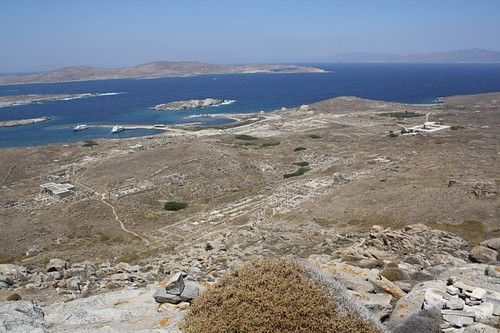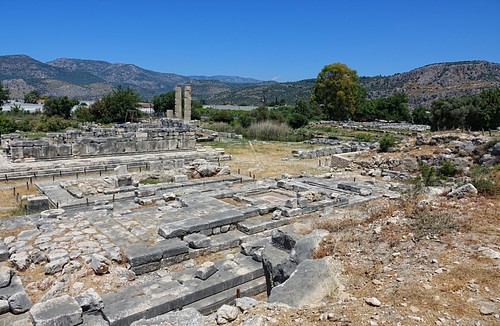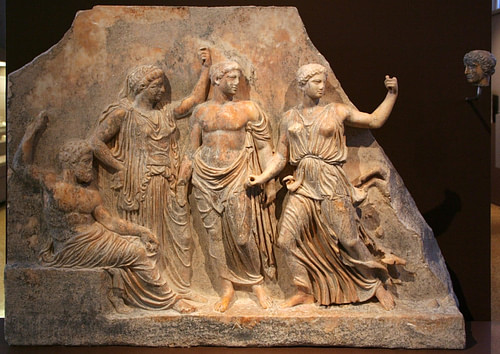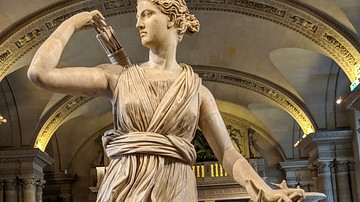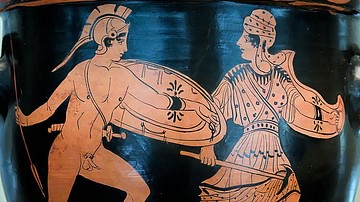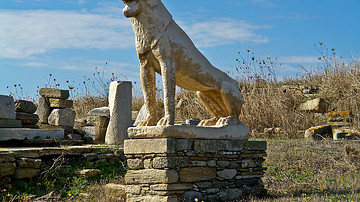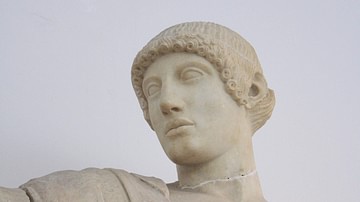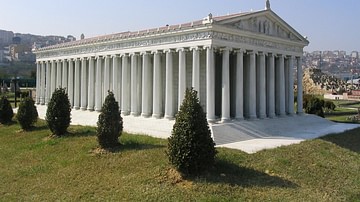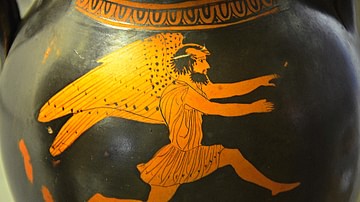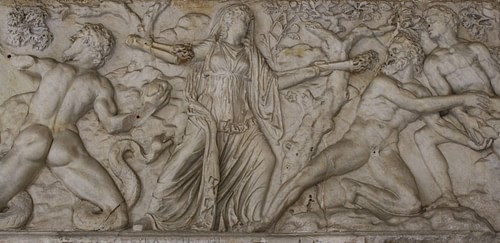
Leto is a Titan and the mother of the gods Apollo and Artemis in Greek mythology. Leto's twin children were the result of an amorous encounter with Zeus, and to avoid his wife Hera's wrath, the Titaness was obliged to give birth on the remote and barren island of Delos. Not involved in very much else in myth, the goddess did, nevertheless, have several sanctuaries dedicated to her, notably the Letoon at Xanthos in today's southern Turkey. She also appears in Greek art, particularly scenes showing her alongside her more famous children. To the Romans, the goddess was known as Latona.
The Birth of Apollo & Artemis
Leto is the daughter of the Titans Coeus (Intelligence) and Phoebe (Moon). She is the mother, with Zeus, of the twin deities Apollo and Artemis. The king of the Olympian gods had changed himself and Leto into quails before they coupled. Leto gave birth to her offspring on the island of Delos, hence its important sanctuary to Apollo. The Titaness, in order to escape the wrath of Zeus' wife Hera, had been forced to travel far and wide across the Aegean because most city-states were too afraid to give aid following Hera's warning of dire consequences if they did. In some versions, Leto is continuously chased by a python sent by Hera. Finally, Leto settled on seemingly her only option: the small and barren island of Delos. In some versions of the myth, Zeus asked his brother Poseidon to create the island with a thrust of his trident, hence the name Delos, which signifies 'appearance' or 'apparent' in ancient Greek. The story does often include the description of Delos as being a floating island and the birth of Apollo somehow made it fixed and stable. Leto is assisted during the difficult delivery by Eileithyia, the goddess of childbirth after she was called from Mount Olympus by the winged messenger Iris. The nine-day delivery was so troublesome that Leto had to grasp hold of a palm tree and olive tree for support.
Aristotle adds the curious and chronology-bending detail that Leto was a she-wolf who came to Delos from the Hyperboreans - a legendary northern race of Apollo-worshippers. There was certainly a traditional association between Apollo and wolves. In addition, the ancient Greeks did consider Delos as the last resting place of the Hyperboreans. Such legends and mix-ups of associations may well have been devised in order to promote Delos above the other great sacred sanctuary to Apollo at Delphi.
The famed specialist of Greek mythology, Robert Graves adds that the quarrel between Hera and Leto may represent an ancient rivalry between settlers from what is today Israel/Palestine and indigenous peoples in Anatolia, each side worshipping a different earth goddess. Curiously, there was a deity called Lat popular in both the eastern Mediterranean and Egypt, a fertility goddess who was particularly associated with the date palm and olive tree. It is also perhaps significant that in Greek mythology, Leto is brought to Delos by a south wind. Besides honouring her son, Delos also possessed a sanctuary specifically dedicated to Leto with a temple within which stood a small wooden statue of the deity.
Sacred Sites
In alternative versions of the above myth, Artemis is born at Ortygia ('Quail Island'), near Ephesus in Western Turkey and so she was particularly worshipped there. In this version, Leto then nipped across to Delos to bear Apollo. Other cult sites which possessed a sanctuary or Letoon dedicated to Leto included those at Tegyra in Boeotia, Zoster in Attica and Xanthos in Lycia, also located in southern Turkey, which all claimed Leto had given birth to her divine children there.
The Titaness had a sanctuary, too, at Didyma on the southeast coast of Turkey where there was a famed oracle of Apollo, and another on the island of Chios. The sites sacred to Leto were usually under the charge of a male priest in Anatolia and a priestess elsewhere. At many sites, Leto had become one with a more ancient and indigenous 'Mother' goddess and so she was often referred to as 'Mother Leto.' The Titaness was often connected to initiation ceremonies of young girls to adulthood, notably at Phaistos on Crete. Further, groups with hereditary membership (phratries) posted the lists of their new members in the Letoon at Athens. Worship of Leto continued into Roman times, especially in Anatolia where festivals and competitions were held in her honour.
The Letoon of Xanthos
Xanthos (aka Xanthus) is of particular interest because it had an important sacred site in honour of the Titaness, the Letoon. Xanthos was the largest city in Lycia and the sanctuary of Leto was located just a few kilometres to the south. The earliest certain remains excavated there date to the 7th century BCE, but there was likely an even older cult at the site dedicated to a local mother goddess symbolised by the presence of a spring. Leto was associated with the site because it was believed she had stopped there with her twins when returning to Mount Olympus from Delos. The Titaness was thought to have washed Apollo and Artemis in the spring, although she was not made welcome and so turned the local inhabitants into frogs. Despite this odd relationship between deity and mortals, worship of Leto was especially promoted by the 4th century BCE ruler of Xanthos, Arbinas (he whose tomb is now in the British Museum in London and referred to as the Nereid Monument).
During the 3rd century BCE, the site benefitted from the addition of three temples and a wall which enclosed the whole sacred precinct. Leto's temple had six Ionic columns on the facades and eleven along each long side. On either side of this main temple were smaller ones dedicated to Apollo and Artemis. In the 2nd century BCE, a theatre was added for the performance of religious ceremonies. In the same century, the sanctuary, now with a well-established history, was made the federal sanctuary of all of Lycia - a status attested to by ancient texts which describe the site as being visited by pilgrims from across the Greek world and by many surviving inscriptions. Indeed, important finds at the sacred site include a useful 4th-century BCE trilingual inscription in Greek, Lycian and Aramaic (concerning a cult to King Caunius). There is, too, a 108-line Greek inscription dating to 208 BCE asking for cash assistance from Cytinium, which was not successful. The Letoon continued to be popular in the imperial Roman period and was even visited by Roman emperor Hadrian (r. 117-138 CE). However, by the 5th century CE, a Christian church had been built at the site using many blocks once used in the pagan temples. In a final blow to the old gods, the interior of Leto's temple was converted into a baptistery.
Leto in Literature & Art
The goddess is described by Hesiod (c. 700 BCE) in his Theogony as "dark-robed Leto, always soothing, gentle to human beings and to the immortal gods, soothing from the beginning, the kindliest one within Olympus" (405-7). Homer, active in the 8th century BCE, describes the Titaness as "lovely-haired Leto" in the Iliad, and in his Odyssey, he mentions in Book 11 (lines 577-81) the story of the Giant Tityus, the son of Gaia (Earth), who is punished for assaulting Leto. The Titaness had called for her children's help when she was abducted by Tityus, and they swiftly appeared and killed him. This was not the end for the Giant, though, for he was then given one of Zeus' delicious punishments, in his case to be staked out on the ground in Tartarus in the depths of Hades where he was later seen by the wandering Odysseus. There, stretched out and defenceless in the deepest and darkest reaches of the Underworld, the Giant's liver is constantly pecked at by two vultures (or an eagle in some versions).
In another myth popular in Greek literature and art, her children once again defend their mother's honour. The huntress goddess uses her bow to mercilessly kill the six (or in some accounts seven) daughters of Niobe while Apollo shoots down her sons, all because she had boasted that her childbearing capacity was greater than Leto's. The story was famously represented on the throne of the Statue of Zeus at Olympia, one of the Seven Wonders of the ancient world.
Leto is most often represented in Greek art - especially statuary and in painted scenes on Greek pottery - as part of a triad were her offspring Apollo and Artemis. Such representations appear as early as the 7th century BCE, notably at Dreros on Crete. The trio famously appears on a metope from Selinus dating to the 6th century BCE. Otherwise, the Titaness is difficult to identify in art without accompanying inscriptions because she has none of the particular attributes seen with Olympian goddesses like Athena's helmet and Demeter's ear of grain. Leto does appear on occasion riding a chariot with her son Apollo on Greek vases or stands by him while he plays his kithara. Leto sometimes appears in scenes showing the birth of Apollo where she often holds on to a palm tree for support. A good example is a 4th-century BCE pyxis or lidded box now in the National Archaeological Museum in Athens. Leto is here strikingly painted in white and she grasps a golden palm tree. We can spot her, too, in depictions of the Tityus myth on a 6th-century BCE metope from Paestum and on several surviving black-figure and red-figure vases over the 6th and 5th century BCE.
